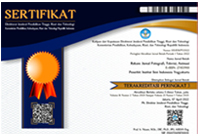Penjejakan Fitur Berbasis Koherensi Temporal dalam Sistem Animasi Ekspresi Wajah
Abstract
Abstrak
Tingginya permintaan produktivitas industri animasi di Indonesia menuntut adanya perubahan
di sektor produksi. Teknologi motion capture merupakan penerapan prinsip visi komputer
yang mengadaptasi indera mata manusia untuk mengenali fenomena gerakan yang tertangkap
kamera dan memetakannya dalam pola gerak virtual. Tulisan ilmiah ini akan membahas metode
penjejakan fitur penanda di wajah manusia untuk mendapatkan informasi mengenai ekspresi
wajah. Teknik penjejakan menggunakan penerapan prinsip koherensi temporal. Asumsi yang
digunakan pada penelitian ini berargumentasi bahwa dengan menggunakan pendekatan
koherensi temporal, maka proses penjejakan fitur di citra sekuensial dapat disederhanakan
dengan perhitungan nilai kedekatan pada penanda di setiap frame-nya. Hasil yang didapat
menunjukkan bahwa proses penjejakan fitur yang diusulkan memiliki hasil yang handal untuk
menangani banyak frame. Komputasi yang digunakan juga sangat efisien dan hemat karena
prosesnya tidak memerlukan tahap pembelajaran terlebih dahulu. Kumpulan hasil penjejakan
parameter fitur penanda secara sekuensial akan membentuk sebuah basis data ekspresi visual
dari wajah manusia.
Abstract
Temporal Coherence Based Feature Tracking in the Animation System of Facial Expression.
High demand on the productivity of the animation industry in Indonesia requires a change
in the existing production process. Motion capture technology is the implementation of a
computer vision principle to adopt the human eye senses to understand the phenomenon of
motion results from a camera and to map the virtual movement patterns. This paper will
discuss a method for tracking marker features in the human face to obtain information about
facial expressions. The tracking technique is using implementation of temporal coherence
principle. This research assumes that by using temporal coherence approach, the tracking
process in sequential images can be simplified by calculating similarity on markers in each
frame. The result shows that this feature-tracking process have reliable result to handle a
lot of frames. The computation used is very efficient and cheap because it does not require
a learning process in advance. The precision accuracy of tracking parameters generated a
database of good visual expression.
Keywords
Full Text:
PDFReferences
Bolkart, T., & Wuhrer, S. 2015. “3D Faces in
Motion: Fully Automatic Registration
and Statistical Analysis”. Computer
Vision and Image Understanding. Vol.
: 100-115.
Chau, D. P., Bremond, F., & Thonnat, M. 2011.
“A Multi-Feature Tracking Algorithm
Enabling Adaptation to Context
Variations”. The International Conference
on Imaging for Crime Detection and
Prevention (ICDP). London.
Dutreve, L., Meyer, A., & Bouakaz, S. 2008.
“Feature Points Based Facial Animation
Retargeting”. Proceedings of the 15th
ACM Symposium on Virtual Reality
Software and Technology.
Ekman, P., & Friesen, W. 1978. Facial Action
Coding System: A Technique for the
Measurement of Facial Movement.
California: Consulting Psychologists
Press, Inc.
Hjortsjo, C. H. 1970. Man’s Face and Mimic
Language. Malm: Nordens Boktryckeri.
Johnson, A. E., & Hebert, M. 1997.
“Recognizing Objects by Matching
Oriented Points”. IEEE International
Conference on Computer Vision and
Pattern Recognition. p. 684-692.
Ko, J. G., Kim, K. N., & Ramakrishna, R. S.
“Facial Feature Tracking for Eye-
Head Controlled Human-Computer
Interface”. IEEE TENCON’99. Cheju.
Parke, F. I. 1972. “Computer Generated
Animation of Face. Proceedings of the
ACM Annual Conference. p. 451-457.
Parke, F. I., & Waters, K. 2008. Computer Facial
Animation. 2nd Edition. Massachusetts:
AK Peters.
Sobottka, K., & Pitas, I. 1997. “A Fully
Automatic Approach to Facial Feature
Detection and Tracking”. International
Conference on Audio and Video-Based
Biometric Person Authentication.
Switzerland: Crans-Montana.
DOI: https://doi.org/10.24821/rekam.v12i2.1425
Refbacks
- There are currently no refbacks.

This work is licensed under a Creative Commons Attribution 4.0 International License.



